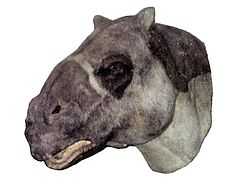Ancylotherium
| Ancylotherium Temporal range: 6.5–2Ma | |
|---|---|
 | |
| Ancylotherium model | |
| Scientific classification | |
| Kingdom: | Animalia |
| Phylum: | Chordata |
| Class: | Mammalia |
| Order: | Perissodactyla |
| Superfamily: | †Chalicotherioidea |
| Family: | †Chalicotheriidae |
| Subfamily: | †Schizotheriinae |
| Genus: | †Ancylotherium |
| Species | |
|
A. hennigi | |
Ancylotherium (from Greek, meaning "hooked beast") is an extinct genus of the family Chalicotheriidae, subfamily Schizotheriinae, endemic to Europe, Asia, and Africa during the Late Miocene-Pliocene (9.0—1.8 mya), existing for approximately 7.2 million years.[1]
Taxonomy
Ancylotherium was named by Gaudry (1863) and was assigned to Chalicotheriidae by Carroll (1988); and to Schizotheriinae by Geraads et al. (2007).[2][3]
Description
At two meters high at the shoulder and a weight of nearly 500 kg, Ancylotherium was relatively large, and was built rather like a goat.[4] Like other chalicotheres, it had long forelimbs and short hind limbs. However, unlike most other chalicotheres, it did not walk on its knuckles. It was similar to the North American genus Moropus.
Environment
Ancylotherium's habitat was the savannahs of East and South Africa. As an herbivore, it evolved to browse on vegetation on the trees in the grassy savannahs of Africa. Ancylotherium's closest relatives are the other perissodactyls, or "odd-toed" ungulates, including the extinct brontotheres and modern-day mammals such as horses, tapirs, and rhinoceroses.
Fossil distribution
Fossil remains of Ancylotherium have been found at many of the hominid fossil sites in East and South Africa, including sites in Laetoli, Olduvai and Omo.
See also
- Moropus (a North American chalicothere)
References
- ↑ PaleoBiology Database: Ancylotherium, basic info
- ↑ R. L. Carroll. 1988. Vertebrate Paleontology and Evolution. W. H. Freeman and Company, New York 1-698
- ↑ D. Geraads, E. Tsoukala, and N. Spassov. 2007. A skull of Ancylotherium (Chalicotheriidae, Mammalia) from the late Miocene of Thermopigi (Serres, N. Greece) and the relationships of the genus. Journal of Vertebrate Paleontology
- ↑ https://sites.google.com/site/paleofilescom/ancylotherium